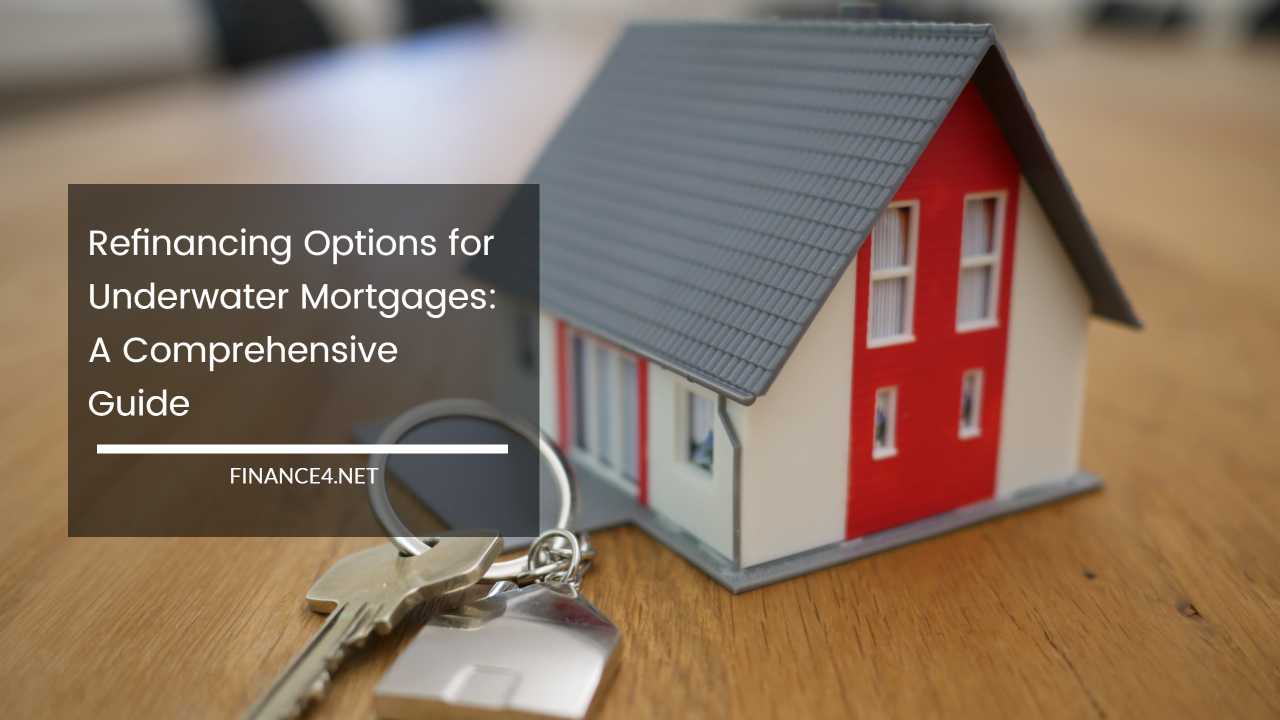Refinancing Options for Underwater Mortgages: A Comprehensive Guide

Underwater Mortgages
An underwater mortgage occurs when a homeowner owes more on their mortgage than the current value of their property.
This situation can arise due to a decline in property values, economic downturns, or high-interest rates on the original mortgage.
Having an underwater mortgage can be financially challenging and may limit homeowners’ options when it comes to refinancing. However, several refinancing options are available to help homeowners in this situation.
In this comprehensive guide, we will explore various refinancing options for underwater mortgages, including government programs, private lenders, and other strategies to help homeowners regain control of their finances and potentially save their homes.
1. Understanding Underwater Mortgages
An underwater mortgage, also known as negative equity, means that the outstanding balance on the homeowner’s mortgage exceeds the current market value of their property.
For example, if a homeowner owes $250,000 on their mortgage, but their property is currently valued at $220,000, they have an underwater mortgage with negative equity of $30,000.
Underwater mortgages can occur for several reasons, including a decline in the local housing market, economic recession, or purchasing a property with a small down payment.
During a housing market downturn, property values may decrease, leaving many homeowners with negative equity.
2. The Challenges of Refinancing an Underwater Mortgage
Refinancing an underwater mortgage can be challenging due to the increased risk to lenders. Since the mortgage balance exceeds the property value, lenders may be hesitant to provide new financing or refinance the existing mortgage.
The reduced equity in the property also makes it difficult for homeowners to qualify for conventional refinancing options.
Additionally, underwater homeowners may face financial hardships, making it harder to meet strict lending criteria, such as credit score requirements and debt-to-income ratios.
Despite these challenges, several refinancing options are available to help homeowners improve their financial situation and potentially save their homes.
3. Government Refinancing Programs
The U.S. government offers various refinancing programs to assist homeowners with underwater mortgages.
These programs are designed to make refinancing more accessible and affordable for those facing negative equity. Two popular government programs are:
a) Home Affordable Refinance Program (HARP):
HARP was introduced to help homeowners with underwater mortgages refinance into more stable and affordable loans.
To qualify for HARP, homeowners must meet certain criteria, including having a loan owned or guaranteed by Fannie Mae or Freddie Mac, being current on mortgage payments, and having a loan-to-value ratio (LTV) greater than 80%.
HARP allows refinancing without requiring an appraisal, making it easier for underwater homeowners to participate.
b) Federal Housing Administration (FHA) Streamline Refinance:
The FHA Streamline Refinance is available to homeowners with FHA-insured mortgages. This program allows eligible homeowners to refinance without an appraisal, income verification, or extensive credit review.
The FHA Streamline Refinance helps homeowners reduce their monthly mortgage payments and can be an attractive option for those with negative equity.
4. Private Lenders and Portfolio Refinancing
Some private lenders and financial institutions offer portfolio refinancing options that may be suitable for underwater homeowners.
Portfolio loans are mortgages that lenders keep in their own portfolios rather than selling them to government-sponsored entities like Fannie Mae or Freddie Mac.
As a result, portfolio lenders have more flexibility in their underwriting guidelines and may be willing to refinance underwater mortgages on a case-by-case basis.
Homeowners can explore portfolio refinancing options with local community banks, credit unions, or mortgage companies that offer specialized loan products.
Keep in mind that these loans may come with higher interest rates or unique terms, so carefully evaluate the terms and conditions before proceeding.
5. Making Extra Payments to Build Equity
One strategy for homeowners with underwater mortgages is to make extra principal payments whenever possible.
By making additional payments towards the mortgage principal, homeowners can build equity faster, which may eventually bring the loan balance closer to the property’s current value.
While this approach may not result in an immediate solution, it can be a proactive step to reduce negative equity over time and improve refinancing prospects in the future.
6. Negotiating with the Current Lender
Homeowners facing negative equity can explore the option of negotiating with their current lender. Some lenders may be willing to modify the terms of the existing mortgage to make it more affordable for the homeowner.
Loan modifications may include interest rate reductions, extended loan terms, or even partial forgiveness of the principal balance.
However, negotiating with the lender can be a complex process, and success is not guaranteed. Homeowners may seek the assistance of a housing counselor or attorney experienced in mortgage negotiations to improve their chances of reaching a favorable agreement.
7. Building Credit and Reducing Debt
Improving credit scores and reducing other debts can enhance homeowners’ financial profiles and increase their chances of qualifying for refinancing options.
Paying bills on time, reducing credit card balances, and resolving any outstanding collections can positively impact credit scores over time.
A stronger credit profile can make homeowners more attractive to lenders and increase their chances of securing favorable refinancing terms.
8. Consider Renting Out the Property
If homeowners are unable to refinance their underwater mortgage and face financial challenges, they may consider renting out the property to generate rental income.
Becoming a landlord can help cover mortgage payments and potentially build equity over time.
However, this option may not be suitable for everyone, as it requires homeowners to become landlords and manage rental properties.
Homeowners should carefully evaluate the responsibilities and costs associated with being a landlord before pursuing this strategy.
9. Seeking Legal and Financial Advice
Navigating the complexities of refinancing underwater mortgages requires careful consideration and expert advice.
Homeowners facing negative equity should seek guidance from financial advisors and legal professionals specializing in real estate and mortgage issues.
A financial advisor can assess the homeowner’s overall financial situation and provide personalized guidance on the best course of action.
Legal professionals can review the mortgage documents, negotiate with the lender, and explore legal options to protect the homeowner’s rights and interests.
Final Remarks
Having an underwater mortgage can be a stressful and challenging situation for homeowners. However, several refinancing options and strategies are available to help alleviate the financial burden and potentially save the home.
Homeowners should explore government refinancing programs, consider portfolio refinancing with private lenders, and focus on improving their financial profiles to increase their chances of qualifying for favorable refinancing terms.
Seeking advice from financial and legal experts can provide valuable insights and guidance on the best approach to tackle negative equity and regain control of one’s financial future.
Frequently Asked Questions (FAQ) – Refinancing Options for Underwater Mortgages
Q1: What is an underwater mortgage?
A1: An underwater mortgage occurs when you owe more on your home loan than the current market value of your property. It’s also known as being “upside down” on your mortgage.
Q2: Why should I consider refinancing an underwater mortgage?
A2: Refinancing can help lower your monthly payments, reduce interest rates, or change your loan terms, making it more manageable to stay in your home and avoid foreclosure.
Q3: What refinancing options are available for underwater mortgages?
A3: Common options include the Home Affordable Refinance Program (HARP), the FHA Streamline Refinance, and traditional mortgage refinancing. Each has specific eligibility criteria.
Q4: How do I determine if I qualify for HARP or FHA Streamline Refinance?
A4: Eligibility criteria can vary, but generally, you must have a good payment history and meet certain loan-to-value (LTV) ratio requirements. Contact your lender or a mortgage professional for specific details.
Q5: Can I refinance if I have missed mortgage payments?
A5: It can be more challenging, but some options may still be available. Contact your lender to discuss your situation and explore potential solutions.
Q6: Will refinancing an underwater mortgage eliminate my negative equity?
A6: Refinancing alone won’t eliminate negative equity, but it can make your mortgage more affordable. Over time, as your home’s value increases and you continue making payments, your equity may improve.
Q7: Are there costs associated with refinancing underwater mortgages?
A7: Yes, there are typically closing costs and fees associated with refinancing. Be sure to factor these expenses into your decision and compare them against potential savings.
Q8: How can I find the best refinancing option for my underwater mortgage?
A8: Consult with mortgage lenders or brokers who specialize in refinancing. They can assess your situation and provide options tailored to your needs.
Q9: Can refinancing help avoid foreclosure if I’m struggling to make payments?
A9: Yes, refinancing can provide relief by restructuring your loan, reducing monthly payments, and making them more manageable. It’s a proactive step to avoid foreclosure.
Q10: What other alternatives should I consider for underwater mortgages?
A10: In addition to refinancing, explore loan modification, short sales, or working with a housing counselor for guidance on available options based on your financial circumstances.
Remember that addressing an underwater mortgage requires careful consideration of your unique financial situation. Seeking advice from mortgage professionals and housing counselors can be invaluable in making the right decision for your home.



